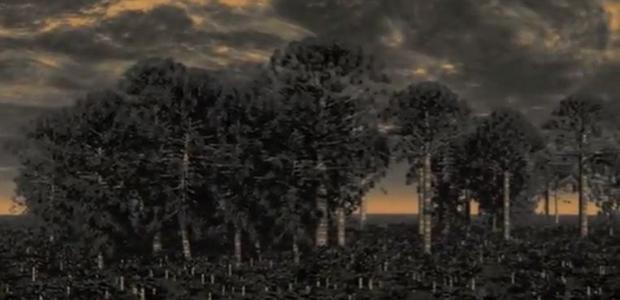Scientist recreates sound of 165 million year-old insect
An illustration of the ancient Jurassic forest where the katydid would have lived. (Contributed photo.)
Scientists know a lot about the time when dinosaurs roamed the earth. They’ve reconstructed fossils and entire eco-systems.
But what they don’t know is what those ancient forests sounded like. A new study published in the Proceedings of the National Academy of Sciences offers a whisper. Or perhaps it should be a chirp.
The study was conducted by Fernando Montealegre-Zapata, a biologist at the University of Bristol, in the United Kingdom. He studies how crickets and katydids communicate with sound.
Last year, he received an unusual request from some paleontologists in China. They had unearthed the fossil of a 165-million-year-old katydid.
“They asked me if I will be able to estimate how this animal [made] sounds – which frequencies this animal was using,” Montealegre-Zapata said.
Male katydids (also known as bush crickets) sing to attract females. They produce their songs by rubbing their wings together. One wing has a toothed vein that’s strummed by the other wing. Montealegre-Zapata examined the ancient Chinese katydid.
“The fossil [had] well developed teeth in both wings,” he said.
He measured those teeth and the length of the wings, and then he figured out what the calls of the prehistoric katydid might have sounded like.
Whereas the songs of most modern-day katydids are made up of a range of notes (“something like shhh shhh shhh shhh – very noisy,” he said), the ancient katydid song consisted of a single note.
The fact that these animals sang a single note suggests that they lived in a noisy environment.
“If you are in a noisy environment, when many animals are singing, and you produce a single note, you will produce a private communication channel just between you and the receiver in the middle of the noise,” he said.
In this case, the receivers of that communication were presumably females of the species. Scientists in China have tracked down fossils of some of those ancient females. Montealegre-Zapata’s now plans to study them, to understand how their ears worked.
An ancient katydid (A. musicus) sings at dusk in a Jurassic forest in Northwestern China. The forest grew under humid
conditions, probably close to the banks of a river and consisted primarily of conifers, in particular giant ferns. Credit for sound and image: Fernando Montealegre-Z, Hinz JK, Smith I, Pfretzschner H-U, Wings O, Sun G.
A katydid found in the Amazonian forests (Panacanthus cuspidatus)sings by rubbing its wings together. Sound and image have been slowed down from original. Credit: Fernando Montealegre-Z.
This is how the field criket, Gryllus bimaculatus sings by rubbing its wings together. Sound and image have been slowed down from original. Credit: Fernando Montealegre-Z.
Our coverage reaches millions each week, but only a small fraction of listeners contribute to sustain our program. We still need 224 more people to donate $100 or $10/monthly to unlock our $67,000 match. Will you help us get there today?
